Since the earliest days of the internet, Isotropic Networks has developed technologies and services that have pushed the satellite industry forward. Even after 30 years of success, the Lake Geneva, WI-based company is driven by the same entrepreneurial spirit it was founded with in a Chicago radio station.
Isotropic serves clients that put a premium on their connectivity: oil and gas companies from the Permian Basin to Pennsylvania; maritime customers in Florida, the Caribbean and the Mediterranean; and utility operators all across the U.S. The satellite telecom company solves complex technical problems, ensuring dependable service and uptime.
“What Isotropic is really all about is unrivaled certainty, so when we make a commitment to our clients, they know we’re going to be there,” said Hank Zbierski, Isotropic’s CEO and chief catalyst.
“To provide true world-class service, we need to be on site and in locations where a commercial flight is impossible or impractical,” added David Greiner, Isotropic’s transformation consigliere. “That often means making trips to customer facilities on a moment’s notice, something only possible using a business aircraft.”
Isotropic flies about 400 hours a year out of Wisconsin’s Burlington Municipal Airport (BUU), where it has a Citation 550 SII, as well as a Cessna 172.
“Business aviation enables us to be specific with the client regarding the date and time we’re going to be there,” explained James Boden, the company’s chief satellite scientist.
The aircraft carry installers, technicians and sales teams to customer sites. When-ever troubleshooting by phone doesn’t resolve an issue, technicians can fly to provide same-day, on-site support.
“We’re not at the mercy of the airlines. We’re always ready to go,” declared Hank.
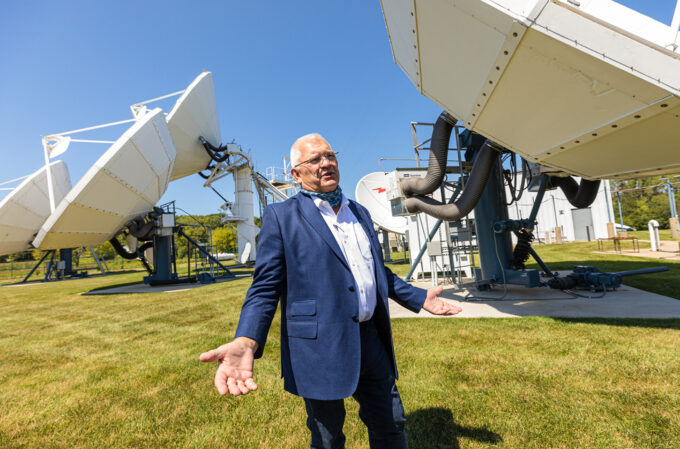
Knowing firsthand the value of business aviation, Hank Zbierski built Isotropic’s large dish array just 10 miles from a GA airport.
Flying From the Start
Isotropic Networks was founded in 1992, and from day one, aviation has been a part of the company’s success.
“I learned how to fly when I was a wet-behind-the-ears salesman,” said Hank. “Aviation has been involved in every business I’ve been in.”
Early on, Isotropic flew a variety of piston-powered aircraft. The company’s first turbine-powered airplane was a Cessna Citation 501, purchased in 2010, the same year that Chief Pilot Ron Nelson, who has over 19,000 flight hours, came aboard.
The Citation 550 SII replaced the Citation 501 when missions required more range and team members on each trip.
“I learned how to fly when I was a wet-behind-the-ears salesman. Aviation has been involved in every business I’ve been in. ”
HANK ZBIERSKI, CEO and chief catalyst, Isotropic Networks
“Our clients have the certainty that we can be on site at a moment’s notice,” said Greiner. “Even with the advancements in remote meeting and communications technology, there is still a big advantage to being face-to-face, especially when we can bring a whole team in.”
Besides customer visits, the jet is also used to pick up associates who work remotely in other states and fly them in for training and important meetings.
“The airplanes have opened the whole world to us,” said Lynn Zbierski, who is Hank’s wife and Isotropic’s president.
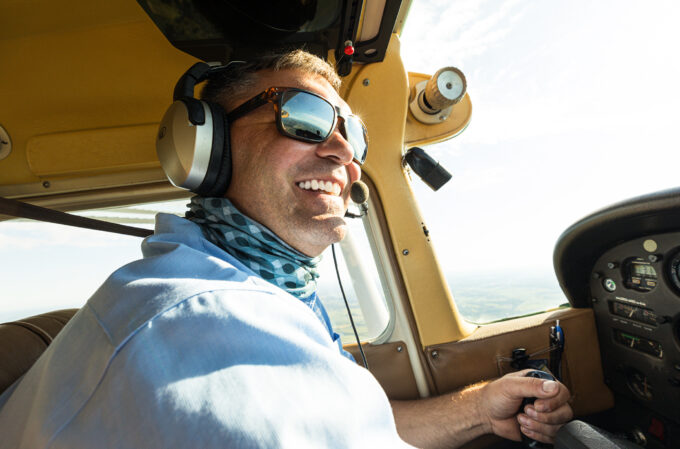
Ryan Zbierski, Isotropic Networks’ director of mission assurance, flies the Cessna 172 single-pilot and serves as first officer on the company jet.
Making It Easy to Work Harder
Nelson is the captain on every Citation SII flight. Hank still flies sometimes, but his son Ryan, who is Isotropic’s director of mission assurance, has taken over much of the business flying. Ryan serves as first officer when the jet is operating in busy airspace, and he flies the Cessna 172 single-pilot on shorter missions around the Midwest.
Ken Nerge is Isotropic’s full-time maintenance technician who pre-flights and post-flights every mission and makes sure the aircraft inspections are up to date.
“Maintenance is where safety begins,” said Nelson. “Fortunately, the Citation SII doesn’t require that much maintenance, but it was built in 1986, so it has a combination of analog and digital systems. So, we need a really good shop that understands how to integrate those.” Isotropic relies on Flightpath of Brooksville, FL, to maintain its aircraft.
The Citation frequently flies between Wisconsin and Fort Lauderdale, FL, where Isotropic has an office. Isotropic also flies to client locations in the Midwest, New Mexico, Utah and much of the East Coast. International destinations include Canada and the Bahamas.
“Business aviation enables us to be specific with the client regarding the date and time we’re going to be there. ”
JAMES BODEN Chief Satellite Scientist, Isotropic Networks
A typical flight to Fort Lauderdale involves up to six employees departing Wisconsin at 7 a.m., conducting meetings en route and arriving at the Florida office by noon. After business is done, the passengers board the jet and are back home by 6 p.m. Because the plane can carry a team of employees, all the decision-makers and key personnel are together, so any topic that comes up is handled on the spot, with very little left unanswered.
Employees who fly on the company airplanes experience the power and efficiency of aviation firsthand. One employee said, “I had never been on a business jet before. It’s fantastic to be able to take a trip with the team without the pain of dealing with [commercial] airports. It’s a big motivator for all of us to work harder.”
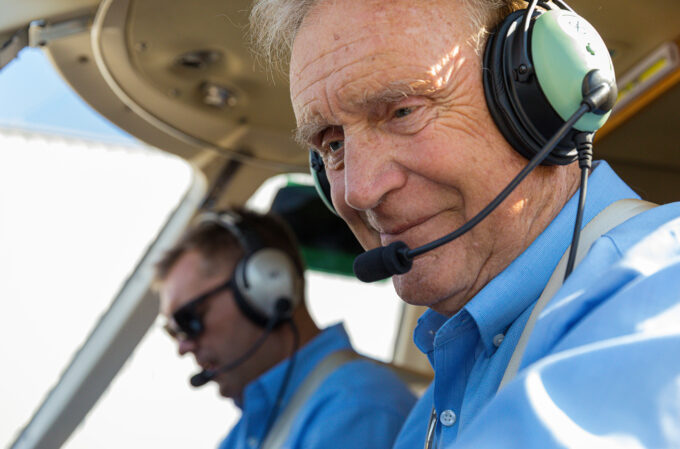
Chief Pilot Ron Nelson (right) and Ryan Zbierski crew the company's Citation 550.
Connecting the Planet
Isotropic’s most important business aircraft flights are rapid-response missions.
“One morning, I went to the hangar at 8 a.m.,” recalled Anthony Philips, an Isotropic technician. “The plane was ready, and an hour later we were in Paducah, KY, where a tug vessel needed a new antenna. We set it up, called our operations center to confirm the signal was strong, and an hour after we boarded that boat, we were back on the plane headed home.”
On trips like these, the planes don’t just carry technicians; they also transport satellite dishes, antennas, routers and cables – components that could not be brought on an airliner. The technicians even use the company hangar to prepare equipment for transport to customer sites.
“When clients have purchased a system with a complex configuration, we can fabricate the equipment, test it and package it in our hangar, in a clean environment, and load it directly onto the plane,” said Ryan.
“Even with the advancements in remote meeting and communications technology, there is still a big advantage to being face-to-face, especially when we can bring a whole team in. ”
DAVID GREINER, Transformation Consigliere, Isotropic Networks
Safety, Confidence & Reassurance
When it came time to write a flight operations manual, Isotropic adopted many of the safety guidelines NBAA provides online to new Part 91 operators.
“Being with NBAA, we can make sure we’re doing things to best practices – training, maintenance, staying current with regulations,” said Ryan.
In preparing for a specific mission, the aviation team assesses many factors, including weather and alternate airports. Max duty time is 12 hours. “The safety of our passengers is – and always will be – the first priority,” declared Greiner.
Isotropic’s pilots get recertified every year to maintain their type ratings. They also occasionally conduct training flights to sharpen their skills for dealing with situations such as high-crosswind takeoffs.
Clearly, business aviation is essential to the service and reliability Isotropic promises clients.
“Having a business airplane gives us the confidence to let our clients know that we can be on-site for them on a moment’s notice,” said Greiner. “This reassures them that they are taken care of. To say they appreciate that is an understatement. We often hear them say to their co-workers, ‘They flew in on their own plane!’”
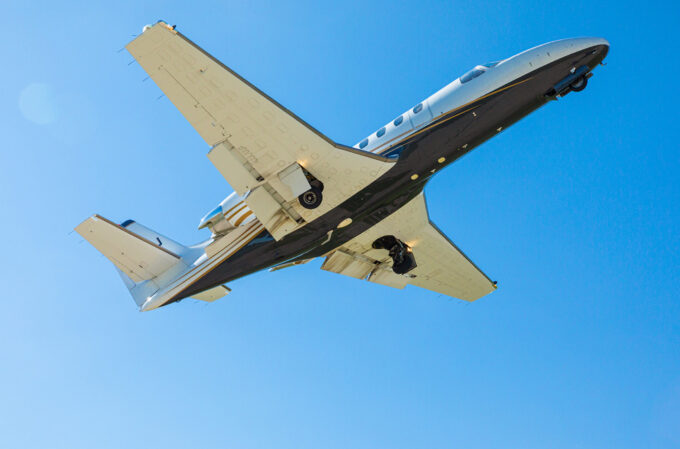
Isotropic Networks’ Citation SII flies from the company’s headquarters in Wisconsin to client locations in the Midwest, New Mexico, Utah and much of the East Coast.
A Unique Employee Benefit: Flight Training
“For our employees, aviation enables them to visit clients they may have only spoken with on the phone, to get out in the field and do install work as well,” said David Greiner, Isotropic’s transformation consigliere.
Isotropic has operated many different aircraft over the last 15 years, starting with a Piper Archer that CEO Hank Zbierski flew to visit customers in five states. After acquiring its first jet, the company added a second airplane: a Cessna 172.
Outfitted with a short-takeoff-and-landing kit, the single-engine piston airplane can utilize runways less than 700 feet long, enabling Isotropic teams to access very rural customers. In addition to being ideal for missions of less than 150 miles, the 172 also enables Isotropic to offer a unique employee benefit: any worker who wants to learn to fly can use the airplane for free. They only need to pay for the instructor’s time.
“If any of our employees want to learn to fly, we take care of everything,” said Hank Zbierski, Isotropic’s CEO and chief catalyst. “I love pilots and aviators working for us, because they’re very disciplined, and our business requires a lot of discipline.”
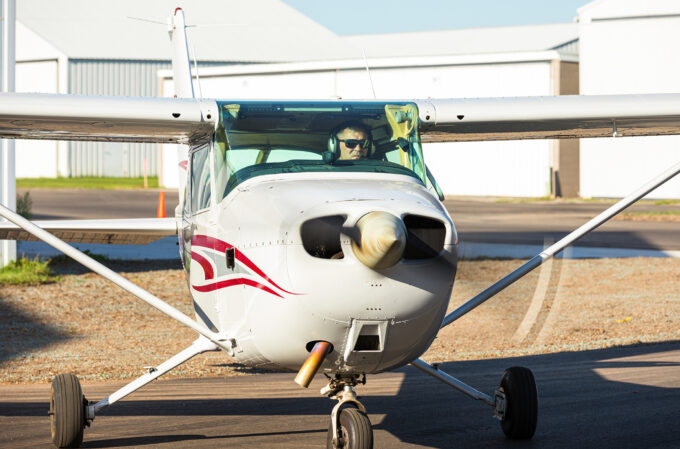
Employees who want to learn to fly can utilize the company's Cessna 172.
Snapshot: Isotropic Networks
Aircraft: One Citation SII and one Cessna 172
Base: Headquartered at Wisconsin’s Burlington Municipal Airport (BUU)
Personnel: One chief pilot, one executive first officer and one maintenance technician



 International Business Aviation Council Ltd.
International Business Aviation Council Ltd.